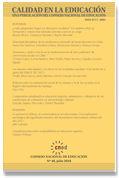Relation between schools and municipalities social composition in the Santiago Metropolitan Region
DOI:
https://doi.org/10.31619/caledu.n48.483Keywords:
democratization of education, school integration, school segregationAbstract
This article addresses the social inclusion of schools. It explores the extent to which the social composition of schools is associated with that of the municipality, based on the premise that this would determine opportunities for school social mix. Data obtained from different sources, namely the fourth-grade results from Simce 2013 and the 2013 Casen Survey, were used to find out if variables based on territory such as population size, household monetary income, social heterogeneity and poverty would predict social composition of schools in the Santiago Metropolitan Area. Since the focus is on the social inclusion of the school, within a general context of segmentation, an appropriate indicator is proposed to make it visible. On average, 20% of fourth-grade students in 2013 attended schools that could be categorized as mixed, with peers from diverse socioeconomic backgrounds. A logistic regression model was used to adjust the data. While the model better predicted segregated schools than mixed ones, it provided valuable clues to understand how territorial variables can affect school mix.
Downloads
Published
Issue
Section
License
Authors retain their Copyright and only transfer a part of these to the journal, accepting the following conditions:
Authors keep their rights as authors and guarantee the right to the journal for the first publication of their work, which is simultaneously subject to the Creative Commons Attribution license allowing third parties to share the study accrediting the author and first publication in this journal.
Authors may adopt other non-exclusive license agreements for distribution of the version of the published work (e.g. inclusion in an institutional thematic file or publication in a monographic volume) accrediting initial publication in this journal.
Authors are allowed and recommended to share their work over the Internet (e.g. in institutional telematic files or their website) before and during the submission process, which may lead to interesting exchanges and increased citation of the published work. (See The effect of open access).

